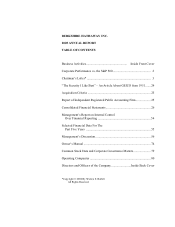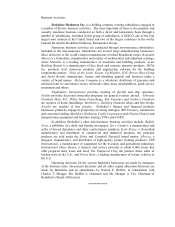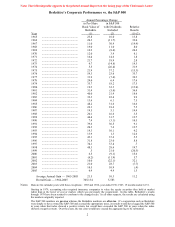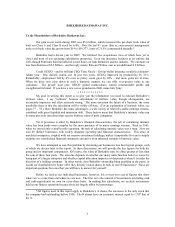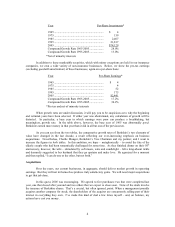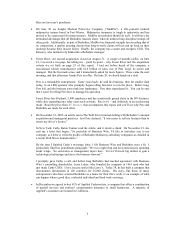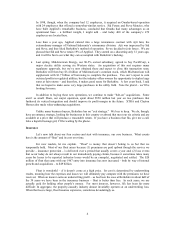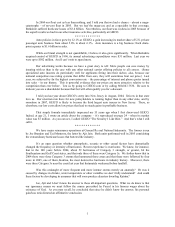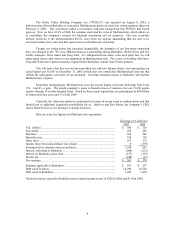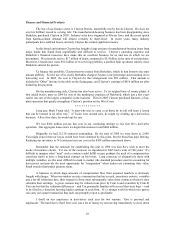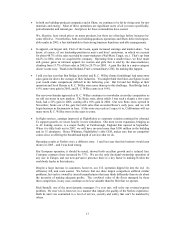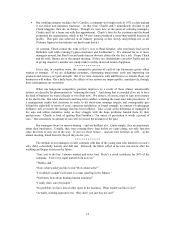Berkshire Hathaway 2005 Annual Report Download - page 7
Download and view the complete annual report
Please find page 7 of the 2005 Berkshire Hathaway annual report below. You can navigate through the pages in the report by either clicking on the pages listed below, or by using the keyword search tool below to find specific information within the annual report.In 1998, though, when the company had 12 employees, it acquired an Omaha-based operation
with 24 employees that offered a somewhat-similar service. Sid Ferenc and Steve Menzies, who
have built Applied’ s remarkable business, concluded that Omaha had many advantages as an
operational base – a brilliant insight, I might add – and today 400 of the company’ s 479
employees are located here.
Less than a year ago, Applied entered into a large reinsurance contract with Ajit Jain, the
extraordinary manager of National Indemnity’ s reinsurance division. Ajit was impressed by Sid
and Steve, and they liked Berkshire’ s method of operation. So we decided to join forces. We are
pleased that Sid and Steve retain 19% of Applied. They started on a shoestring only 12 years ago,
and it will be fun to see what they can accomplish with Berkshire’ s backing.
• Last spring, MidAmerican Energy, our 80.5% owned subsidiary, agreed to buy PacifiCorp, a
major electric utility serving six Western states. An acquisition of this sort requires many
regulatory approvals, but we’ ve now obtained these and expect to close this transaction soon.
Berkshire will then buy $3.4 billion of MidAmerican’ s common stock, which MidAmerican will
supplement with $1.7 billion of borrowing to complete the purchase. You can’ t expect to earn
outsized profits in regulated utilities, but the industry offers owners the opportunity to deploy large
sums at fair returns – and therefore, it makes good sense for Berkshire. A few years back, I said
that we hoped to make some very large purchases in the utility field. Note the plural – we’ ll be
looking for more.
In addition to buying these new operations, we continue to make “bolt-on” acquisitions. Some
aren’ t so small: Shaw, our carpet operation, spent about $550 million last year on two purchases that
furthered its vertical integration and should improve its profit margin in the future. XTRA and Clayton
Homes also made value-enhancing acquisitions.
Unlike many business buyers, Berkshire has no “exit strategy.” We buy to keep. We do, though,
have an entrance strategy, looking for businesses in this country or abroad that meet our six criteria and are
available at a price that will produce a reasonable return. If you have a business that fits, give me a call.
Like a hopeful teenage girl, I’ ll be waiting by the phone.
Insurance
Let’ s now talk about our four sectors and start with insurance, our core business. What counts
here is the amount of “float” and its cost over time.
For new readers, let me explain. “Float” is money that doesn’ t belong to us but that we
temporarily hold. Most of our float arises because (1) premiums are paid upfront though the service we
provide – insurance protection – is delivered over a period that usually covers a year and; (2) loss events
that occur today do not always result in our immediately paying claims, because it sometimes takes many
years for losses to be reported (asbestos losses would be an example), negotiated and settled. The $20
million of float that came with our 1967 entry into insurance has now increased – both by way of internal
growth and acquisitions – to $49 billion.
Float is wonderful – if it doesn’ t come at a high price. Its cost is determined by underwriting
results, meaning how the expenses and losses we will ultimately pay compare with the premiums we have
received. When an insurer earns an underwriting profit – as has been the case at Berkshire in about half of
the 39 years we have been in the insurance business – float is better than free. In such years, we are
actually paid for holding other people’ s money. For most insurers, however, life has been far more
difficult: In aggregate, the property-casualty industry almost invariably operates at an underwriting loss.
When that loss is large, float becomes expensive, sometimes devastatingly so.
6

